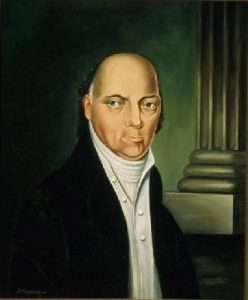The Volokh Conspiracy
Mostly law professors | Sometimes contrarian | Often libertarian | Always independent
Today in Supreme Court History: October 25, 1795
10/25/1795: Justice John Blair resigns from the Supreme Court.

Editor's Note: We invite comments and request that they be civil and on-topic. We do not moderate or assume any responsibility for comments, which are owned by the readers who post them. Comments do not represent the views of Reason.com or Reason Foundation. We reserve the right to delete any comment for any reason at any time. Comments may only be edited within 5 minutes of posting. Report abuses.
Please to post comments


Myers v. United States, 272 U.S. 52 (decided October 25, 1926): President can remove officers appointed with consent of Senate (here, a postmaster) without Senate approval, even though Constitution is silent on the issue; striking down 1876 statute and (finally) striking down the Tenure of Office Act under which Andrew Johnson had been impeached
Gegiow v. Uhl, 239 U.S. 3 (decided October 25, 1915): alien cannot be excluded on grounds that "overstocked labor market" in Portland (Ore.) would likely result in him becoming a public charge; grounds must be nation-based, not locality-based
Vicksburg & M.R. Co. v. Putnam, 118 U.S. 545 (decided October 25, 1886): in FELA action, judge should have instructed jury that they are not bound by actuarial tables showing life expectancy, but can use their own judgment
“(finally) striking down the Tenure of Office Act under which Andrew Johnson had been impeached”
Ackshually, under Grant, Congress changed the statute to specify that a President could remove his Cabinet members without consulting the Senate. What Johnson got impeached for – removing the Secretary of War without Senate approval – became legal again.
This was the only other picture I could find of him on google images, so it looks like a bit a both.<a https://www.let.rug.nl/usa/images/john_blair.jpg
I don't think there were a lot of well trained painters here in those days.
Worse than the Sutherland portrait of Churchill.
From Wikipedia:
John Blair Jr. (April 17, 1732 – August 31, 1800) was an American Founding Father, who signed the United States Constitution as a delegate from Virginia and was appointed an Associate Justice on the first U.S. Supreme Court by George Washington.
Blair was one of the best-trained jurists of his day. A widely respected legal scholar, he avoided the tumult of state politics, preferring to work behind the scenes. He was devoted to the idea of a permanent union of the newly independent states and was a loyal supporter of fellow Virginians James Madison and at the Constitutional Convention. While serving on the Supreme Court, he influenced the interpretation of the Constitution in a number of important decisions. Contemporaries praised Blair for his ability to penetrate to the heart of legal questions, as well as his gentleness and benevolence.
There are other images of him and the one Blackman choose seems to be the worst. Not a great looking guy, but not as bad as the image in this post.
The Wikipedia picture is also awful.
They may not have achieved photorealism right before the invention of the camera, but were they this bad?
Sutherland illustrated what everyone else knew but wouldn’t say: Churchill was an old man who was no longer up to the job. In fact he should have retired in 1945.
Come to think of it, maybe he did look that weird.